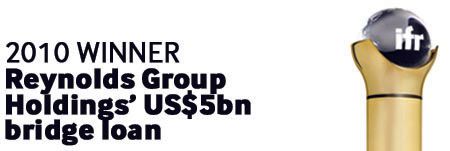Leveraged Loan
Packing a hefty punch: Reynolds Group Holdings’ US$6.1bn acquisition of Pactiv was backed by one of the largest leveraged financing packages of 2010, encompassing bridge loans, loans and bonds. An innovative structure that helped to clinch a complex and high-risk cross-border acquisition, Reynolds Group Holdings’ US$5bn bridge loan is IFR’s Leveraged Loan of the Year.

New Zealand billionaire Graeme Hart’s Reynolds Group Holdings had been looking to buy a global services business for some time. Rival company Pactiv – manufacturer of Hefty food storage and rubbish bags – was in play after talks with private equity firm Apollo Global Management surfaced in mid-May.
However, the failure of payment processor Fidelity National Information Services’ huge US$15bn buyout in the US and lingering volatility from the Greek sovereign debt crisis had dented faith in jumbo buyouts, giving trade buyers the edge in an aggressive auction.
Hart was looking for a financing package that would allow him to minimise his equity cheque and maximise debt. He wanted an innovative financing structure that would allow existing bonds to stay in place as well as new debt to be issued.
Other bidders struggled to secure financing on sufficiently attractive terms but Hart received strong underwriting commitments totalling US$5bn from three banks. The acquisition was announced on August 16.
The difficult cross-hemisphere acquisition, which was the largest of a US publicly listed company by an Asia-Pacific competitor, needed a global platform. The bank group would have to manage a complex multi-product solution and co-ordinate difficult relationship, coverage and time zone issues.
Credit Suisse – Reynolds’ house bank and lead left on the transaction – underwrote US$3bn. HSBC, which acts as Reynolds global retail bank, underwrote US$1.5bn and ANZ made one of its largest acquisition commitments of US$500m.
“The three banks were instrumental in garnering the momentum that helped us raise the funds that backed the transaction … We had wonderful results,” said Tom Degnan, CEO of Reynolds Group Holdings.
Selling such a large leveraged corporate acquisition financing posed another set of challenges. Combined leverage was high at 6.2 times and banks were also bridging to unsecured bond issuance with low Caa1/B– and Baa3/BB credit ratings when market capacity was unclear further down the credit curve.
Reynolds paid US$4.6bn for Pactiv’s equity, funded with a US$3.5bn bridge to senior secured loans, a US$1.5bn bridge to senior bonds and US$734m of new equity contributed by Reynolds owner Rank Group, reduced further by US$300m of balance sheet cash.
The three lead banks were unable to backstop the acquisition as a bank loan as is normal in M&A financing: documentation on Reynolds’ existing debt prohibited taking security in ordinary loan format.
The US$5bn bridge loan covered the issue of loans and bonds but the leads were unable to size the bank piece until they had secured an amendment from existing lenders.
An existing credit agreement limited Reynolds to issuing only US$750m in term loans using an accordion feature, along with up to US$2.75bn of secured notes and US$1.5bn of unsecured notes. Reynolds asked its banks to allow it to increase the accordion to US$2bn in the amendment. It also wanted to cut the size of the bonds by moving some of the secured notes to secured term loans to aid syndication, cut Reynolds’ financing cost and help the lead banks to de-risk.
“We were upsizing both bank and bonds as we were underwriting the transaction,” said Tom Newberry, head of global leveraged finance capital markets and syndicated loans at Credit Suisse.
The banks agreed the amendment and by September 20 Credit Suisse had closed a US$2.02bn leveraged loan consisting of a US$500m term loan A and a US$1.525bn term loan D. It became the second-largest institutional loan of 2010 when it was increased by US$500m on September 24.
The loans, which were also the largest delayed draw term loans since 2007 to compensate investors for the lengthy M&A process, were reverse flexed by 75bp across the spread, Libor floor and OID by 75bp. It was the biggest reverse flex since June. Loan investors were also offered incentives to join the bonds.
The high-yield bond market helpfully rallied and by October 6, CS had priced US$3bn of high-yield bonds that consisted of US$1.5bn of senior secured notes and US$1.5bn of senior unsecured notes. They came at tighter pricing than originally envisaged, 7.125% and 9% respectively.
The high-yield bond was five times oversubscribed, while the term loans were three times oversubscribed and the loan broke for trading over par in a deal that worked for the company, its lead banks and investors.
“Reynolds was just a great deal – a good M&A transaction for the market and the company,” a loan investor said.
Tessa Walsh





